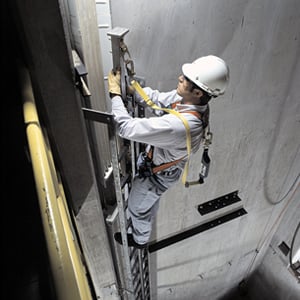Tips to Break Fall Trends in the Workplace

Construction is one of the noisiest workplace environments. Yet, what needs to be heard the most is the recurrent injury and fatalities data that screams "danger." While OSHA's top 10 most violated safety standards lists Fall Protection at No. 1, there are three additional violations on the list that are directly related: Scaffolding, Ladders, and Fall Protection ? Training Requirements. These incidents collectively are responsible for dangerous people and equipment falls. What can workplaces, particularly those in the construction industry, do to curtail these types of violations and injuries?
Highest Causes and Problems
Falls in the workplace might seem minor, but there are times when they can end in disability or death. There were 880 worker deaths and 244,000 injuries attributed to falls in 2019, a significant increase from 2018, according to the Bureau of Labor Statistics. Most were in the construction industry and were to a lower level, occurring from roofs, scaffolds, bridges, and other high surfaces. What causes those types of falls from heights? Here are the common areas:
- Bridges and roofs: Workers can fall if they overreach or stand on unstable items while performing a task. Falls can happen when edges of surfaces are not protected or when holes and openings are not covered or marked. Weather and other environmental conditions, such as condensation in indoor storage areas, can create slippery surfaces.
- Equipment: Tools and equipment, such as elevated work platforms, need great braking control and operator training. Loads should not exceed weight limits. Use the correct size and scale of equipment for the work being done. For example, ladder types and sizes.
- Scaffolding: Falls can occur when scaffolds do not support the correct weight requirements. Falls can also happen when they are not directly connected to roofs and floors, and counterweights with the correct resistance, or do not have appropriate suspension ropes.
A few examples of scaffolding violations in 2019 were scaffolding near energized power lines and no safe access to scaffold work platforms (climbing the scaffold rather than using a ladder). In another incident, a forklift was used to elevate a scaffold platform.
"Construction is a high-hazard industry, so employers must provide all of the necessary safeguards to protect workers from serious or fatal injuries," said OSHA official Paula Dixon-Roderick in 2020 after a scaffolding hazard report in New Jersey.
Reinforce Safety

How can workplaces meet obligations for safety and their responsibility to protect workers from falls? Before work begins, and as a crucial step in any safety program, workplaces need to perform a job hazard analysis.
- JHA: Assess workplaces for fall hazards, including slip and trip potential. Minor design flaws on platforms can result in major consequences for injuries. For example, look for oil and water spills, broken stairs, unprotected edges, tool locations, and cluttered walkways.
- Equipment: Evaluate the equipment works should be using. For example, use stand ladders for quick jobs, but rolling platform ladders for longer work tasks.
- PPE: Personal protective equipment is essential. The right type of fall protection (restraint or arrest systems) should be readily available for the task and worker who will be performing the work.
After the evaluation, the real work begins. Leaders will not only need to make the changes but must also make sure work is done safely and that it follows OSHA compliance.
The weight of these responsibilities rests on management to make sure tasks are done and done right. However, a teamwork effort should be made because worker participation is essential for success. Continuous worker training is valuable in workplace safety, efficiency, and compliance assurance. Additional worker support can be created through classes, toolbox talks, educational apps, and more as part of well-established safety programs. In the construction setting, companies can make sure that workers keep up their OSHA cards.
Injuries and accidents can happen at any time without proper vigilance. Train workers to help make sure their work area is safe and clean. Workers should also know what to do for fall prevention, protection, emergencies or rescues, and safety compliance. Reminders can be put in place, such as signs, labels, and other markings to reinforce safe behaviors and protocol. Maintain a culture that keeps workers on alert and a concerted effort for health and safety.
Related Resources

OSHA and Ironworkers Partner for Safety Outreach
OSHA and Ironworkers are partnering up to help boost safety programs and prevent the most common injuries, ...
Read
Stand-Down Underscores Importance of Fall Protection
OSHA's National Safety Stand-Down, happening May 4-8, 2020, works to minimize the number of workplace falls ...
Read
Do Not Miss a Step in Ladder Safety Training
A government study found that most workers say they have not been trained on how to use a ladder safely. ...
Read.png)





